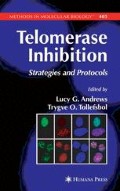Summary
Genetic experiments using a dominant-negative form of human telomerase (DN-hTERT) demonstrated that telomerase inhibition can result in telomeric shortening followed by proliferation arrest and cell death by apoptosis. Neoplastic cells from telomerase RNA null (mTERC−/−) mice showed enhanced chemosensitivity to doxorubicin or related double-strand DNA break (DSB)-inducing agents. Telomerase dysfunction, rather than telomerase inhibition, is proposed to be the principal determinant governing chemosensitivity specifically to DSB-inducing agents. We observed that imatinib and vincristine (VCR), in addition to DSB-inducing agents, also enhanced chemosensitivity in telomestatin-treated K562 cells. This observation suggests that combined use of telomerase inhibitors and imatinib or other chemotherapeutic agents may be a very useful approach to treatment of BCR-ABL-positive leukemia.
Access this chapter
Tax calculation will be finalised at checkout
Purchases are for personal use only
Referencs
Blackburn, E., and Greider, C. (eds) Telomeres. New York: Cold Spring Harbor Laboratory Press, 1995.
van Steensel, B., Smogorzewska, A., and de Lange, T. TRF protects human telomeres from end-to-end fusions. Cell, 92: 401–413, 1998.
de Lange, T., and Jacks, T. For better or worse? Telomerase inhibition and cancer. Cell, 98: 273–275, 1999.
Harley, C.B. Telomere loss: mitotic clock or genetic time bomb? Mutat. Res., 256: 271–282, 1991.
Bodnar, A.G., Ouellette, M., Frolkis, M., Holt, S.E., Chiu, C.P., Morin, G.B., Harley, C.B., Shay, J.W., Lichtsteiner, S., and Wright, W.E. Extension of life-span by introduction of telomerase into normal human cells. Science, 279: 349–352, 1998.
Kiyono, T., Foster, S.A., Koop, J.I., McDougall, J.K., Galloway, D.A., and Klingelhutz, A.J. Both Rb/p16INK4a inactivation and telomerase activity are required to immortalize human epithelial cells. Nature, 396: 84–88, 1998.
Jiang, X.R., Jimenetz, G., Chang, E., Frolkis, M., Kusler, B., Sage, M., Beeche, M., Bodnar, A.G., Wahl, G.M., Tlsty, T.D., and Chiu, C.P. Telomerase expression in human somatic cells does not induce changes associated with a transformed phenotype. Nat. Genet., 21: 111–114, 1999.
Morales, C.P., Holt, S.E., Ouellette, M., Kaur, K.J., Yan, Y., Wilson, K.S., White, M.A., Wright, W.E., and Shay, J.W. Absence of cancer-associated changes in human fibroblasts immortalized with telomerase. Nat. Genet., 21: 115–118, 1999.
Hahn, W.C., Counter, C.M., Lundberg, A.S., Beijersbergen, R.L., Brooks, M.W., and Weinberg, R.A. Creation of human tumor cells with defined genetic elements. Nature, 400: 464–468, 1999.
Wang, J., Hannon, G.J., and Beach, D.H. Risky immortalization by telomerase. Nature, 405: 401–402, 2000.
Weitzman, J.B., and Yaniv, M. Rebuilding the road to cancer. Nature, 400: 401–402, 1999.
Hahn, C.W., Stewart, S.A., Brooks, M.W., York, S.G., Eaton, E., Kurachi, A., Beijersbergen, R.L., Knoll, J.H.M., Meyerson, M., and Weinberg, R.A. Inhibition of telomerase limits the growth of human cancer cells. Nat. Med., 5: 1164–1170, 1999.
Zhang, X., Mar, V., Zhou, W., Harrington, L., and Robinson, M.O. Telomere shortening and apoptosis in telomerase-inhibited human tumor cells. Genes Dev., 13: 2388–2399, 1999.
Artandi, S.E., Chang, S., Lee, S.L., Alson, S., Golllieb, G.D., Chin, L., and DePinho, R. Telomere dysfunction promotes non-reciprocal translocations and epithelial cancers in mice. Nature, 406: 641–645, 2000.
Wright, W.E., and Shay, J.W. Telomere dynamics in cancer progression and prevention: fundamental differences in human and mouse telomere biology. Nat. Med., 6: 849–851, 2000.
Maida, Y., Kyo, S., Kanaya, T., Wang, Z., Yatabe, N., Tanaka, M., Nakamura, M., Ohmichi, M., Gotoh, N., Murakami, S., and Inoue, M. Direct activation of telomerase by EGF through Ets-mediated transactivation of TERT via MAP kinase signaling pathway. Oncogene, 21: 4071–4079, 2002.
Sawyers, C.L., McLauglin, J., Goga, A., Havlik, M., and Witte, O. The nuclear tyrosine kinase c-Abl negatively regulates cell growth. Cell, 77: 121–131, 1994.
Kharbana, S., Kumar, V., Dhar, S., Pandey, P., Chen, C., Majumder, P., Yuan, Z.-M., Whang, Y., Stauss, W., Pandia, T.K., Weaver, P.D., and Kufe, D. Regulation of the hTERT telomerase catalytic subunit by the c-Abl tyrosine kinase. Curr. Biol., 10: 568–575, 2000.
Vigneri, P., and Wang, J.Y.J. Induction of apoptosis in chronic myelogenous leukemia cells through nuclear entrapment of BCR-ABL tyrosine kinase. Nat. Med., 7: 228–234, 2001.
Baur, J.A., Zou, Y., Shay, J.W., and Wright, W.E. Telomere position effect in human cells. Science, 292: 2075–2077, 2001.
Shin-ya, K., Wierzba, K., Matsuo, K., Yamada, Y., Furihata, K., Hayakawa, Y., and Seto, H. Telomestatin, a novel telomerase inhibitor from Streptomyces anulatus. J. Am. Chem. Soc., 123: 1262–1263, 2001.
Author information
Authors and Affiliations
Editor information
Editors and Affiliations
Rights and permissions
Copyright information
© 2007 Springer
About this protocol
Cite this protocol
Tauchi, T., Ohyashiki, J.H., Ohyashiki, K. (2007). Telomerase Inhibition Combined with Other Chemotherapeutic Reagents to Enhance Anti-Cancer Effect. In: Andrews, L.G., Tollefsbol, T.O. (eds) Telomerase Inhibition. Methods in Molecular Biology™, vol 405. Humana Press. https://doi.org/10.1007/978-1-60327-070-0_14
Download citation
DOI: https://doi.org/10.1007/978-1-60327-070-0_14
Publisher Name: Humana Press
Print ISBN: 978-1-58829-683-2
Online ISBN: 978-1-60327-070-0
eBook Packages: Springer Protocols

